Five Games Masters and Players You See at Every RPG Con
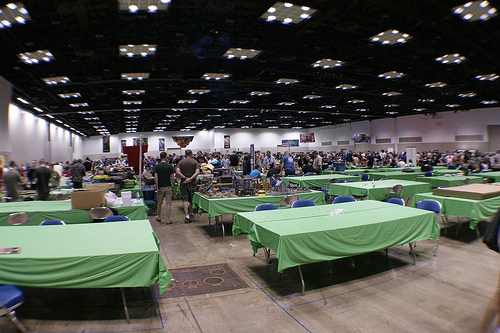 |
| Carlos A. Smith Photography |
Gaming cons are quite possibly my favorite times of the year, a brief but glorious long weekend wherein the only worries are making it to games in time, staying awake through games, and eating so you can go play more games. It’s like being a kid again, but you get to stay up really late. Although there is a dealer room, it is not particularly commercialized, and the local cons tend to be attended by the same major gaming clubs every time, so there’s a good sense of community.
All of that happy-fuzzy stuff aside, after running and playing games at cons for over a decade I’ve started to notice a few archetypes you see every time. Some can be celebrated, some can be a little terrifying, and they could all do with a little bit of mockery. So, without further ado, here are ten people you will see at a gaming con, split into Game Masters (them what run the game) and players (those what play).
The Game Masters:
1. The Unprepared GM
The Unprepared GM has had as much time as anyone else to put a scenario together but fell prey to the dread beast procrastination. A prepared GM will have STUFF – character descriptions, a snappy intro, maybe a map or three – whereas the Unprepared GM has little more than a special badge and a glassy eyed stare. They will become more difficult to spot by about day 3 of con, as the Unprepared GM will become hard to distinguish from Exhausted, Hungover or Malnourished GM. Is the GM’s blank stare because they have no idea how to answer your question, or because a hangover is squeezing their brain like a massive spider? (For the purpose of this example, the spider both squeezes things and is invisible).
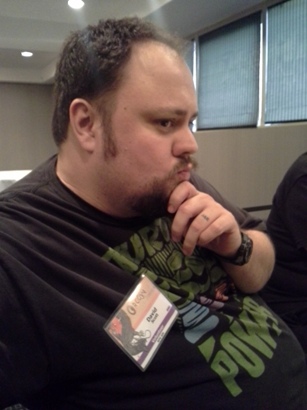 |
| Maybe if I look thoughtful, they won’t notice I forgot my books. |
Dead giveaways are a lack of character sheets, those little mcguffins that tell you what the virtual you is capable of and how good he or she is at it. A GM who tries to write up characters at con or guide others through the process at the table either vastly overestimates the skill of most people to instantly pick up a game, knows exactly who will be playing or just had no alternative. Another giveaway – when the GM switches games on you at the last minute. At the last con I attended, a GM decided to switch from werewolves characters to ordinary humans in a zombie-pocalypse since the ‘adventure was too hard’ with the number of players who showed up. I don’t buy it, but on the plus side I got to make a Sea Captain. I like Sea Captains! (Arrrrr is for role-playing.)
2. The Edition Warrior GM
There is a certain type of GM who lets their tastes get a bit rigid at some point or another. The stereotype for someone getting stuck in their ways is usually AD&D (say, from the ’80s) but these days you even find people willing to grognard about DND 4th Edition (first released in the ancient year of 2008 and technically still the most current edition of the game). How you get emotionally attached to something that’s only existed for five years, I’m not sure. But then again my daughter is currently spending 30-40% of her time fawning over Sherlock, which came out in 2010, so maybe I don’t understand real obsession.
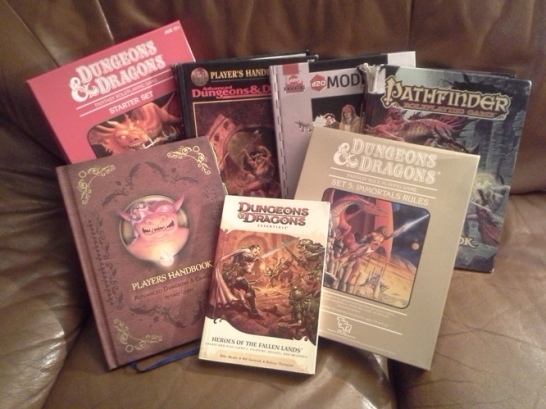 |
| This picture alone could start a thousand flame wars. |
With these guys it becomes like those people on Facebook who regularly cite “Obama” or “the Republicans” whenever a post even vaguely related gives them an opportunity. These edition true-believers only play one system (and generally only one edition of said system) and take up any opportunity to say vaguely or directly unflattering things about those who play others. A typical enough fandom rivalry, except within a fandom so tiny, maybe we should all appreciate each other. On the upside, at least they don’t think they’re saving the world with copy paste arguments, unlike the wannabe pundits on Facebook. Well, probably. I’m not sure with some. Did I mention they take this stuff really, really seriously?
3. The Sequel Writer GM
It’s rare when a Game Master literally repeats games across cons, though I do know at least one GM who does exactly that. He has beautiful handouts, nicely decorated character sheets, and has a pre-set scenario that gives a group of players a lot of reasons to murder each other, then watches them fight it out. When it gets boring, he drops demons in to accelerate the action. It’s sort of like a bored kid filling a box with bugs and shaking it until they kill each other, except it’s actually a lot of fun for the bugs, probably because they aren’t really dying.
However, it is fair to say each GM has a default style and when they’ve run games at a con for a long time, you can pretty much expect what will happen. My wife and I run a Gaslamp (or Steampunk, if you like) game that depends on the players getting excited about playing the same group of Victorian-ish characters and getting into monster-themed adventures twice every con. I have a friend who runs investigation games that consist of driving out to Nowhere, America and talking to bored truck stop waitresses about flashing lights for the first 2-3 hours followed by a big fight pretty much every time. And then there’s Pathfinder Society, which receives their games from a central geek HQ and runs them according to the book. (No EXCEPTIONS. There are rules, sir!)
And why do we do that? Honestly, even though GMing offers theoretically unlimited potential, it is easier to run similar scenarios over and over again. It’s difficult to come up with a totally original scenario every time, and it also gives some comforting continuity to people who like picking up the same character con after con. It can, however, come across as a bit lazy, which I say despite doing it myself. I guess it’s like movies – I still enjoy Fast and Furious sequels but I know they make some people want to jump off the nearest bridge (which, being in real life and not in the Fast and Furious universe, would actually kill them). Even GMs know sequels sell.
4. The Salesperson GM
In the late 90s, many role-players (myself included) had a dream of one day being an RPG creator. I worked for ages on a homebrew RPG, but it never truly got off the ground and when the D20 movement came along, it seemed pointless. Soon after, RPG publishing was not immune to the effects the Internet had on the general publishing world, and recently I’ve heard there are more professional astronauts in the world than professional RPG writers. This doesn’t stop some, though. They are working on publishing game systems with a mindset that the market is still there for small publishers. Admittedly, with Kickstarter and other new resources for the indie publisher things seem to be looking up for them, but overall it’s a tough road. Going to Cons is a logical way to build up some audience for your game and even though it can take a bit more convincing for people to play a game they’ve never heard of, a bit of campaigning can go a long way.
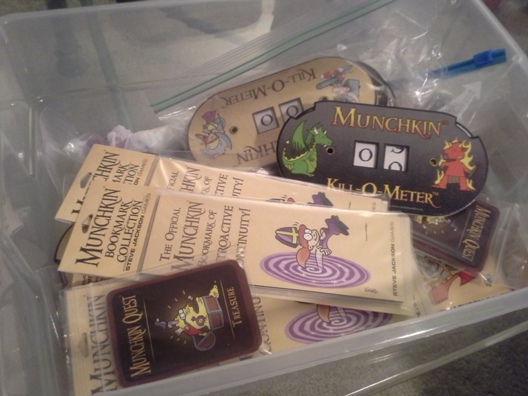 |
| Seriously. Prizes! I got a whole box of them! |
On a less indie wavelength, there are big game companies who also try to tap the con marketplace by providing perks and bennies to those willing to run/demo games. My wife and I perform this service for SJ Games, having been recruited by friends. There are also clubs such as the aforementioned powerful Pathfinder Society and its rival, the DnD centered Role Playing Games Association (See Edition Warrior). Now, most of these groups are very hands-off and just assume that running a fun game will get people interested, so there’s nothing all that shady about it (plus we have prizes! PRIZES!). But still, an official game may have a very different flavor than an unofficial one (Like, we might make you fill out forms. People hate that.) Not that this is always a bad thing, as you can at least assume your GM is familiar with the gaming system and probably won’t be completely reshaping it in his own twisted image with custom rules molded by his twisted obsessions and shoddy understanding of the real world. (Hey, that sort of reminds me of a Lindelof production.)
5. The Creeper GM
RPG cons are, for the most part, fairly wholesome affairs with families and such running around. Geekdom may have a pop-culture rep for sexual twists and strangeness but I would say an RPG con is pretty far removed from a super sexed-up furry convention. That’s not a value judgment, I’m just saying as far as sex goes it’s a different vibe (ha!). Unfortunately there are still some creepers out there, and they can sometimes interact badly with their fellow humans in person. Generally even creepers can keep things under control for four hours, but sometimes a GM gets a little too creepy or involved with sexual innuendo. For example, I’ve played in games where a liberal amount of rule 34 had been applied to Velma, and I also may have played Conan once in a game and participated in an orgy. But none of you were there, so you can’t prove anything.
 |
| I got this game idea from a fan fic I read. It’s hot. |
All of which can be fine in an Adults Only game, but when a creeper GM hooks up with a creeper player it can be the worst. In my experience, the most discomforting version of this scenario is when a creepy male GM interacts with a creepy female player (yes, women can be creepers, too.) This is because when a female player starts drawing from the well of perversion most male bystanders seem to be too dumbfounded, amused, or aroused to put any stop to it, while the rest of us twitch nervously. This can lead to all kinds of dark places, from creepy interrogation scenes to long, detailed lists of sexual conquests. This sort of role-playing can be fine in the proper setting, usually with people you know well, late at night, maybe with a few beers involved, but when you’re sitting at a table getting bored while the GM and a player go off on detailed sexual fantasy tangents, it can make the sexy go bad and creepy if not just boring/clinical. Sort of like bad fan fiction.
The Players:
1. The Uber-Geek Player
Now, with rare exception, tabletop gamers are also geeks, maybe more so than most. And these days, there are certain things geeks just assume other geeks are going to be familiar with. I think some of this is because in the dark, pre-Internet geekdom was a small underground hive-mind, but these days there’s so damn much geek in our pop culture that you can certainly live a geek life without exploring every nook and cranny of every franchise. However, there are some people who are such omni-consumers of all things geek it can make you question your own fandom. Not surprisingly they often have trouble communicating with people outside of this sort of paradigm and think that being at a gaming con is their crossing the Red Sea moment – that is, they have found their people.
What’s wrong with that, you ask? Well, nothing, really, but when you’re sitting at a six person table with a flesh and blood wiki fan site that can’t speak a single sentence without referencing Serenity, Doctor Who, or a random comic book, conversations can get difficult. Especially when they give you an eager and desperately hopeful look after each reference, apparently expecting you to laugh.
Chris Hardwick demonstrates at the 3 minute mark
Something like –
“What is your character doing?”
“He’s standing out under the stars. You can’t take the sky from me!”
“Er… fine, yes. Serenity, funny. Then, what will you do?”
“Do I see any blue phone booths?”
“Ah, no – no, phone booths. Funny Doctor Who reference there. But really, what is your character doing?”
“I keep lookout – after all, this is a wretched hive of scum and villainy, amirite?”
And so on. I mean, I can’t be mad at the guy because I understand the jokes. It’s just that constant sci-fi references aren’t really, you know, funny. And they can get a little disruptive when you’re trying to keep everyone focused, and once, just once, I want things to go according to the gorram plan!
2. The Attention-Starved Player
One thing about con games is that they generally lack continuity. In an ongoing game, you get attached to your characters and the game itself, so losing them tends to be No Fun. There can be some expectations: heroic deaths, hilarious mishaps, a high level D&D game where true resurrection is a regular facet of gameplay, etc. But the usual goal is to survive the session and keep playing your character. Con games, in contrast, end at a certain time regardless of what happens. So dying won’t lead to much more than a few hours of downtime, which you might be craving due to lack of sleep and food anyway.
The problem is when you combine this lack of self-preservation with some of the more anti-social player behaviors, things can get bad fast. Inter-player fighting, characters running off on their own, or players pursuing their own special agenda are the main things that tend to happen and tend to just irritate the other players. Some players disrupt game play, by trying to join the enemy army, running in guns blazing during a stakeout (LEEEEEEEROY JENKINS!), or starting fights with the authorities for no reason.
Now, part of the advantage of a tabletop game over a video game RPG like the Fallout series is supposed to be that you can go off the rails. Where the problem starts is when people get too far off the rails, then start dragging everyone else with them. I get that sometimes there are really irritating NPCs in video games that you wish you could just tell off or smack around, but the game makes them invincible, or makes you put your sword away, or whatever. So it’s empowering to be able to tell your tabletop GM that you punch that guard in the mouth – those moments can even be awesome. Unfortunately, players are also capable of telling their GM they want to start teabagging all the NPCs, or go on a murder spree, or pretty much anything their twisted minds can think of. And that can leave scars that never fade, especially with strangers.
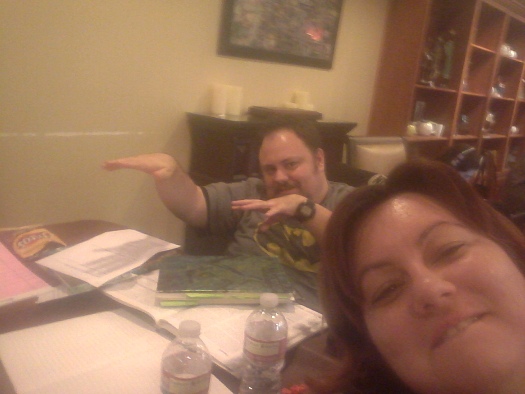 |
| They also might photo bomb your con pics. |
3. The Unsuspecting Significant Other Player
At some point in going to con, you will spot the slightly bewildered would-be player whose boy/girlfriend thought that a gaming convention was an excellent time to introduce them to their hobby. Maybe their significant other really likes Game of Thrones, maybe they play World of Warcraft but never tried tabletop before, maybe the gamer in question is really nice/rich/hot (hey, it happens) and the non-gamer is just indulging them, but it is up to you, the GM, to not only explain the game, but make sure their non-gaming S.O. has a great time, or their inevitable break up will be all your fault. (No pressure!) This is especially fun when the gamer half of the relationship has clearly done nothing to adequately explain their gaming hobby before dragging their S.O. to your table, leaving the GM to not only explain the basics of the particular game system, but RPGs as a whole, which totally does not waste a precious chunk of the 4 hour window you have to run a game for 4 other players who are clearly eyeing the table at the other end of the room and wondering if they have any open slots.
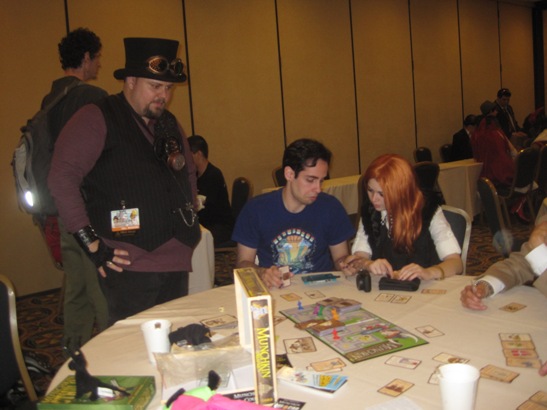 |
| Nope. Still don’t get it. Can we go to the Brony panel now? |
Maybe worse, though, are the non-role-players who still want to sit at the table next to their S.O. (To offer some sort of moral support?) Thus, you have one person looking completely bored among a bunch of people who you are trying to get fired up and into the action. You start to wonder if they couldn’t go to the bar and have a drink? Are they dating their parole officer and not allowed to get out of eyesight? It’s sort of an aggressive form of non-participation. There are plenty of bored people at, say, a baseball game, but you don’t see them sitting around on the field, idly shuffling their feet and looking off into the distance. Though, being as it’s baseball, it wouldn’t exactly slow down the “action.”
4. The Hardcore Player:
A con will run more or less night and day, and it’s a fair statement to say that you can game almost the entire time (though, say, 4 a.m. – 8 a.m. gets pretty sparse). My daughter will do an iron woman run and barely visit her bed the entire time. Of course, she’s a few decades younger than me and full of energy so she can do it. But we grownups have to make a few command decisions to actually get some sleep here and there.
 |
| Evidence a hardcore gamer is nearby… |
That is, except for the hardcore gamer. Despite being old enough to know better, they still attend games from 9 a.m. to 4 a.m. every day at the con. Somehow, they manage to keep playing, throwing their dice long after they should be collapsing. How do they do it?
To be fair, those of us well out of college tend to have a lot of competition for our time, we can have trouble finding players, some people only get to game around con season, or it’s the only thing overwhelming enough to let them mentally escape a miserable life for a while. This might be their only gaming experience for the whole year. So, it’s understandable these people try to eke every bit of enjoyment out of con. And, in my experience, it tends to somehow strengthen them. Living embodiments of the maxim ‘whatever doesn’t kill me makes me stronger’, they gain more and more frantic energy until they yell every sentence and collapse into laughing fits at everything vaguely funny. They are difficult to pick out during the day, but god help you if you, like me, get talked into playing a Sesame Street/Resident Evil crossover that starts at midnight on the last night of con. Even as you, mere mortal gamer, get more and more tired until you can barely remember what system you’re playing, the hardcore gamers just keep laughing and laughing and get louder and louder. After a while, they’re scarier than the zombies. Even the Muppets.
5. The Gamer Girl Player
Most well-balanced gaming clubs I know have a substantial group of female gamers. (Yes, really.) As my wife likes to explain it, role-playing is fundamentally improv with rules, and that’s not something that is gender-dependent in the slightest. There is a societal assumption that gamer geeks are geeks because they are just so far removed from the females of the species, but in point of fact there are a fair amount of female players at RPG cons. And unlike the larger comic book conventions, these tend to be people here to play a game and not aspiring models dressed in leather or chainmail bikinis, trying to sell posters. There is still a cosplay presence, both male and female (mainly LARP enthusiasts) but it doesn’t seem to be as overwhelming a showing as, say, SDCC. You rarely see a gaming table without 1-2 female players. There are no ‘fake geeks’ at a gaming con; it’s just too damn geeky for that nonsense.
There is also a strong tendency to have families attend con all together, so you even see a decent amount of mothers at the con. They tend to be maybe a bit tired or distracted, but once things get moving they have a good time. They get a mental break from corralling their little goblins by hacking up dragons, which is good therapy for anyone.
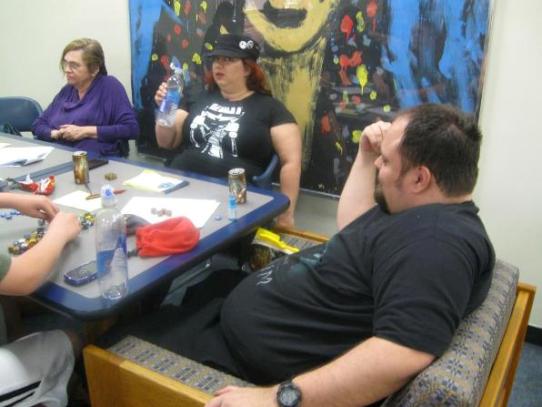 |
| Proof! |
Usually all this mixed-gender game play goes just fine, but I have noticed a bit of a tendency for the flirtatiousness to kick up considerably at gender-mixed tables. Probably because we all like role-playing characters more attractive than we are, and it’s a lot easier to go along with it if the person is at least a member of the gender you are attracted to, regardless of how they actually look like. It’s certainly easier than pretending that the 250 pound dude with the beard and stubble next to you is a leather-clad assassin that looks “kind of like a medieval Black Widow”. (Have fun getting that mental image out of your head.)
Most photos in this story are from the personal collection of David N. Scott
